Diploma in Education and Training: Assessment and Communication Report
VerifiedAdded on 2022/08/29
|40
|9100
|94
Report
AI Summary
This report, created for a Diploma in Education and Training, comprehensively addresses various aspects of teaching and learning. It begins by exploring behaviour management, including operant conditioning, pedagogical principles such as specialist knowledge and kinaesthetic learning, and the differences between group and individual behaviour management. The report then delves into assessment, examining the role of initial and diagnostic assessments in setting individual learning goals and the effectiveness of different assessment methods. It also investigates communication theories, including those of Piaget, Bernstein, and Vygotsky, and their impact on learning. The report uses practical examples from teaching practice to analyze the benefits and limitations of different communication methods and assessment strategies, and provides SWOT analysis. The report also includes a table listing different types of assessments and their purposes.
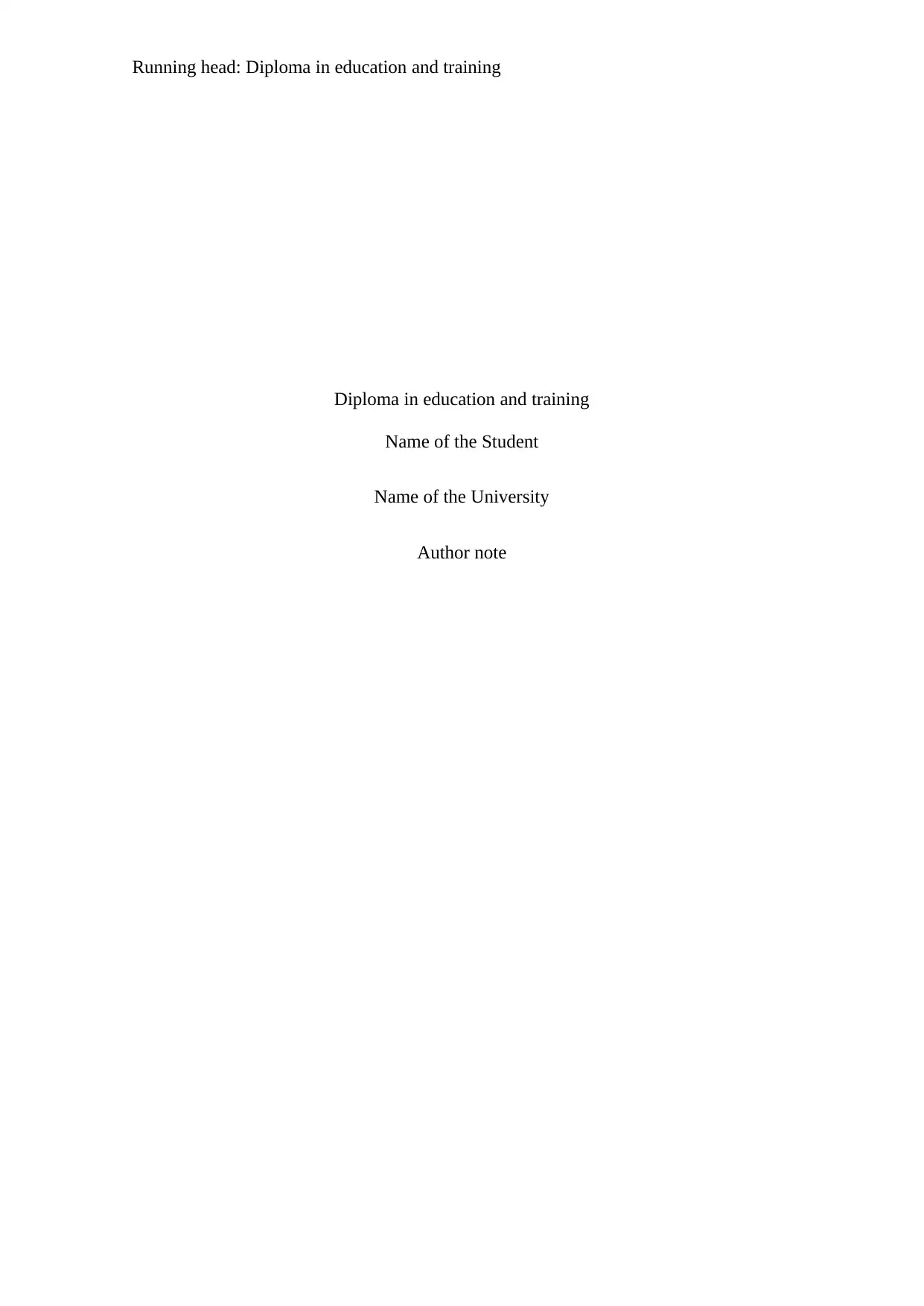
Running head: Diploma in education and training
Diploma in education and training
Name of the Student
Name of the University
Author note
Diploma in education and training
Name of the Student
Name of the University
Author note
Paraphrase This Document
Need a fresh take? Get an instant paraphrase of this document with our AI Paraphraser
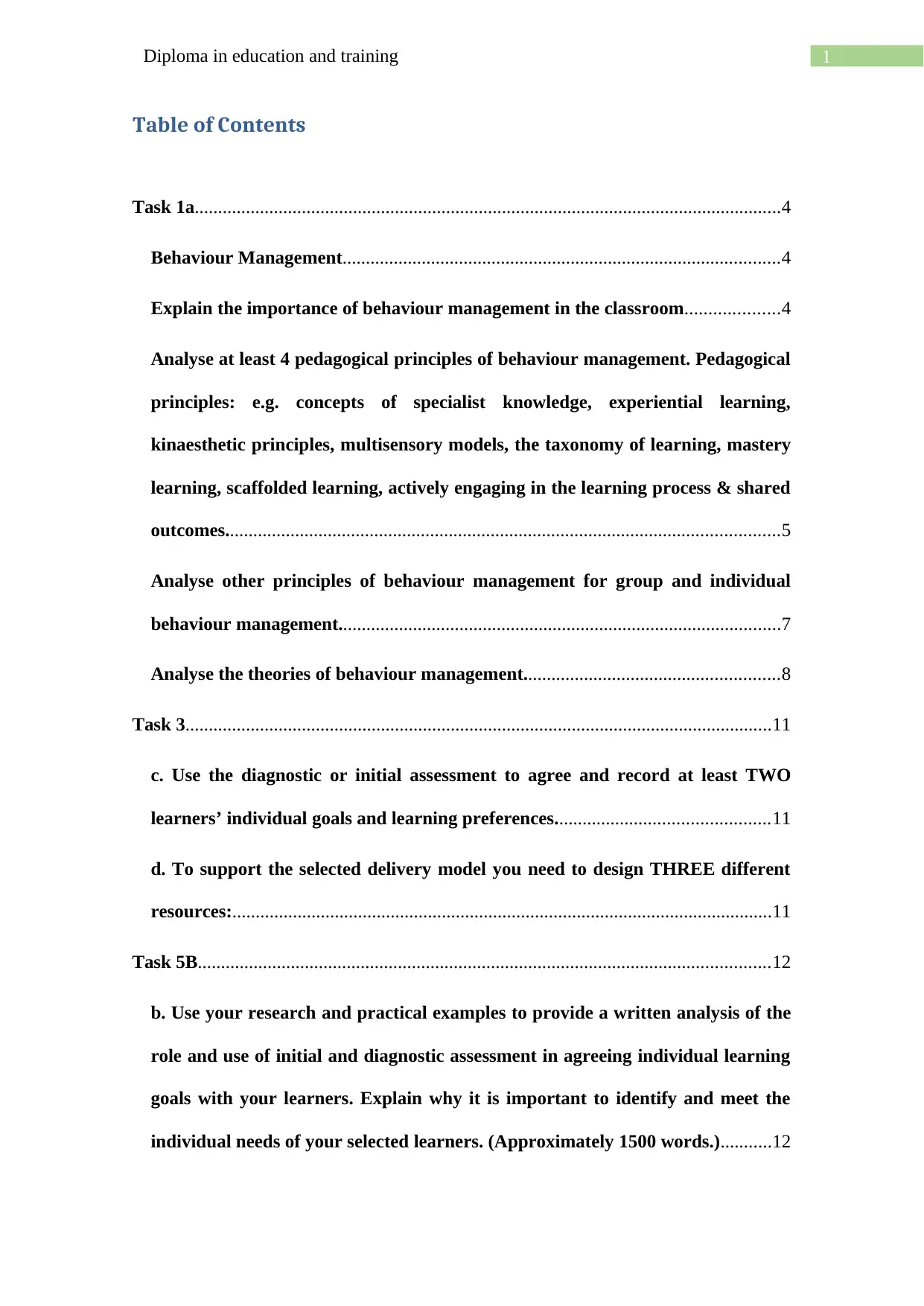
1Diploma in education and training
Table of Contents
Task 1a..............................................................................................................................4
Behaviour Management..............................................................................................4
Explain the importance of behaviour management in the classroom....................4
Analyse at least 4 pedagogical principles of behaviour management. Pedagogical
principles: e.g. concepts of specialist knowledge, experiential learning,
kinaesthetic principles, multisensory models, the taxonomy of learning, mastery
learning, scaffolded learning, actively engaging in the learning process & shared
outcomes.......................................................................................................................5
Analyse other principles of behaviour management for group and individual
behaviour management...............................................................................................7
Analyse the theories of behaviour management.......................................................8
Task 3..............................................................................................................................11
c. Use the diagnostic or initial assessment to agree and record at least TWO
learners’ individual goals and learning preferences..............................................11
d. To support the selected delivery model you need to design THREE different
resources:....................................................................................................................11
Task 5B...........................................................................................................................12
b. Use your research and practical examples to provide a written analysis of the
role and use of initial and diagnostic assessment in agreeing individual learning
goals with your learners. Explain why it is important to identify and meet the
individual needs of your selected learners. (Approximately 1500 words.)...........12
Table of Contents
Task 1a..............................................................................................................................4
Behaviour Management..............................................................................................4
Explain the importance of behaviour management in the classroom....................4
Analyse at least 4 pedagogical principles of behaviour management. Pedagogical
principles: e.g. concepts of specialist knowledge, experiential learning,
kinaesthetic principles, multisensory models, the taxonomy of learning, mastery
learning, scaffolded learning, actively engaging in the learning process & shared
outcomes.......................................................................................................................5
Analyse other principles of behaviour management for group and individual
behaviour management...............................................................................................7
Analyse the theories of behaviour management.......................................................8
Task 3..............................................................................................................................11
c. Use the diagnostic or initial assessment to agree and record at least TWO
learners’ individual goals and learning preferences..............................................11
d. To support the selected delivery model you need to design THREE different
resources:....................................................................................................................11
Task 5B...........................................................................................................................12
b. Use your research and practical examples to provide a written analysis of the
role and use of initial and diagnostic assessment in agreeing individual learning
goals with your learners. Explain why it is important to identify and meet the
individual needs of your selected learners. (Approximately 1500 words.)...........12
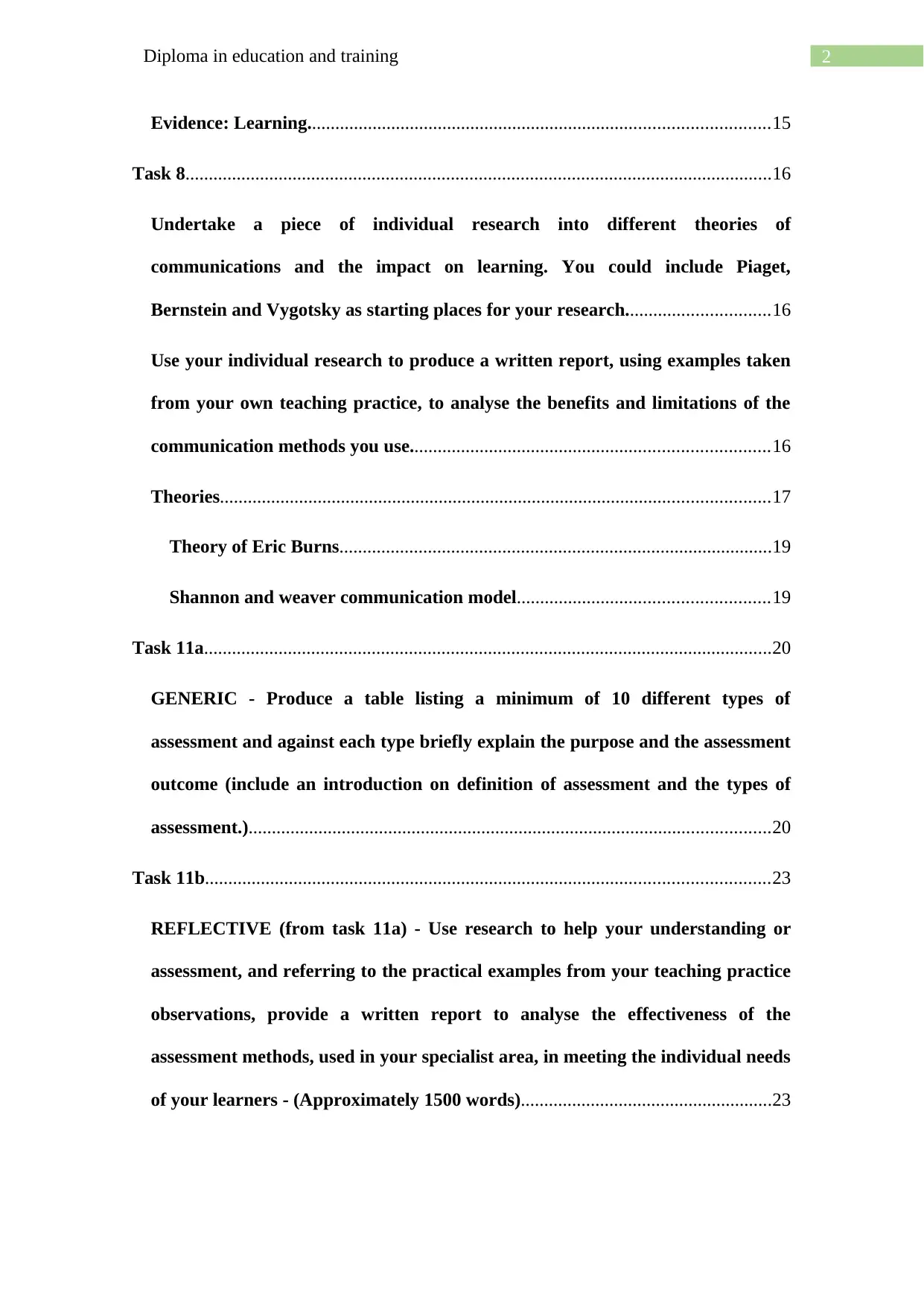
2Diploma in education and training
Evidence: Learning...................................................................................................15
Task 8..............................................................................................................................16
Undertake a piece of individual research into different theories of
communications and the impact on learning. You could include Piaget,
Bernstein and Vygotsky as starting places for your research...............................16
Use your individual research to produce a written report, using examples taken
from your own teaching practice, to analyse the benefits and limitations of the
communication methods you use.............................................................................16
Theories......................................................................................................................17
Theory of Eric Burns.............................................................................................19
Shannon and weaver communication model......................................................19
Task 11a..........................................................................................................................20
GENERIC - Produce a table listing a minimum of 10 different types of
assessment and against each type briefly explain the purpose and the assessment
outcome (include an introduction on definition of assessment and the types of
assessment.)................................................................................................................20
Task 11b.........................................................................................................................23
REFLECTIVE (from task 11a) - Use research to help your understanding or
assessment, and referring to the practical examples from your teaching practice
observations, provide a written report to analyse the effectiveness of the
assessment methods, used in your specialist area, in meeting the individual needs
of your learners - (Approximately 1500 words)......................................................23
Evidence: Learning...................................................................................................15
Task 8..............................................................................................................................16
Undertake a piece of individual research into different theories of
communications and the impact on learning. You could include Piaget,
Bernstein and Vygotsky as starting places for your research...............................16
Use your individual research to produce a written report, using examples taken
from your own teaching practice, to analyse the benefits and limitations of the
communication methods you use.............................................................................16
Theories......................................................................................................................17
Theory of Eric Burns.............................................................................................19
Shannon and weaver communication model......................................................19
Task 11a..........................................................................................................................20
GENERIC - Produce a table listing a minimum of 10 different types of
assessment and against each type briefly explain the purpose and the assessment
outcome (include an introduction on definition of assessment and the types of
assessment.)................................................................................................................20
Task 11b.........................................................................................................................23
REFLECTIVE (from task 11a) - Use research to help your understanding or
assessment, and referring to the practical examples from your teaching practice
observations, provide a written report to analyse the effectiveness of the
assessment methods, used in your specialist area, in meeting the individual needs
of your learners - (Approximately 1500 words)......................................................23
⊘ This is a preview!⊘
Do you want full access?
Subscribe today to unlock all pages.

Trusted by 1+ million students worldwide
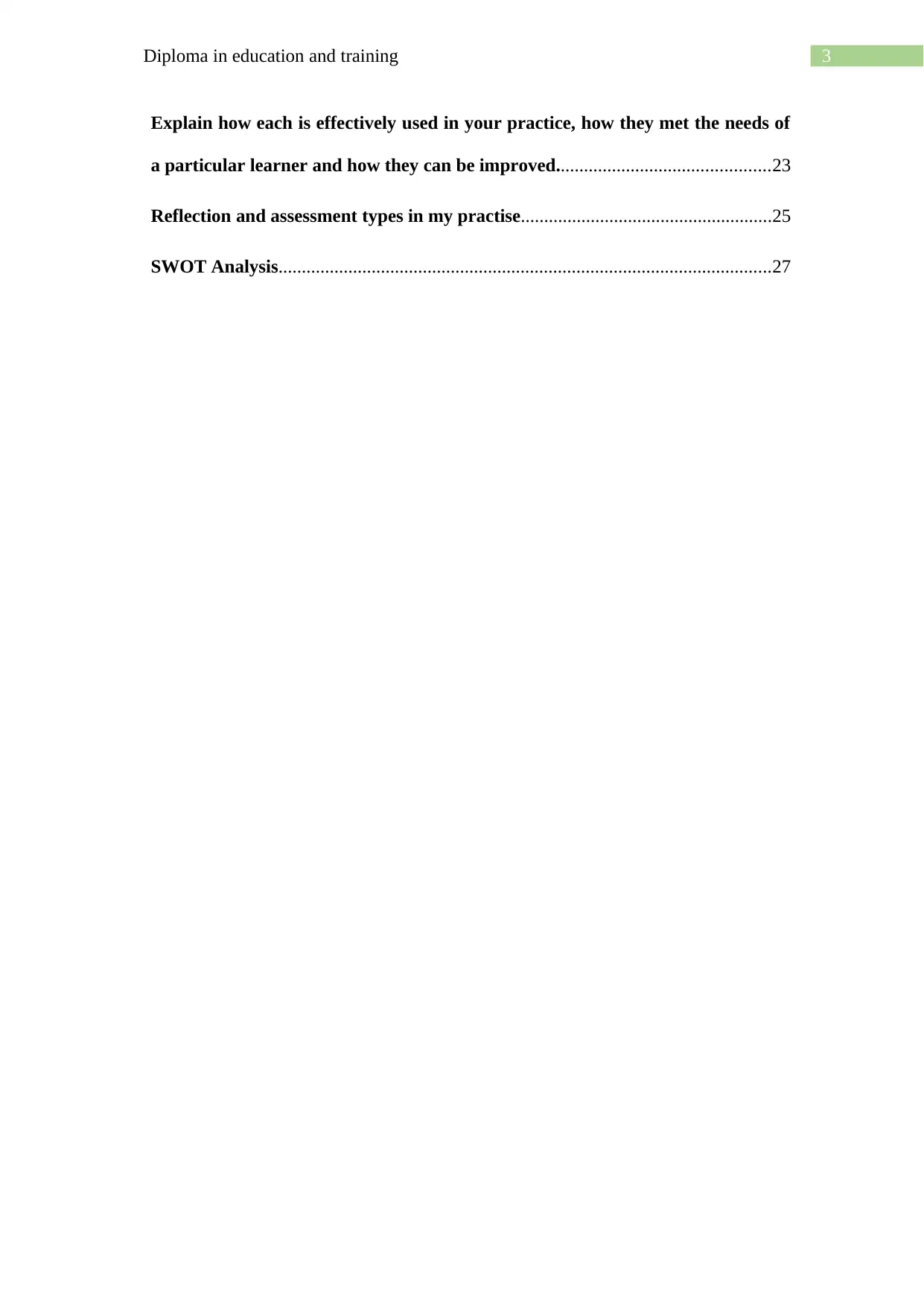
3Diploma in education and training
Explain how each is effectively used in your practice, how they met the needs of
a particular learner and how they can be improved..............................................23
Reflection and assessment types in my practise......................................................25
SWOT Analysis..........................................................................................................27
Explain how each is effectively used in your practice, how they met the needs of
a particular learner and how they can be improved..............................................23
Reflection and assessment types in my practise......................................................25
SWOT Analysis..........................................................................................................27
Paraphrase This Document
Need a fresh take? Get an instant paraphrase of this document with our AI Paraphraser
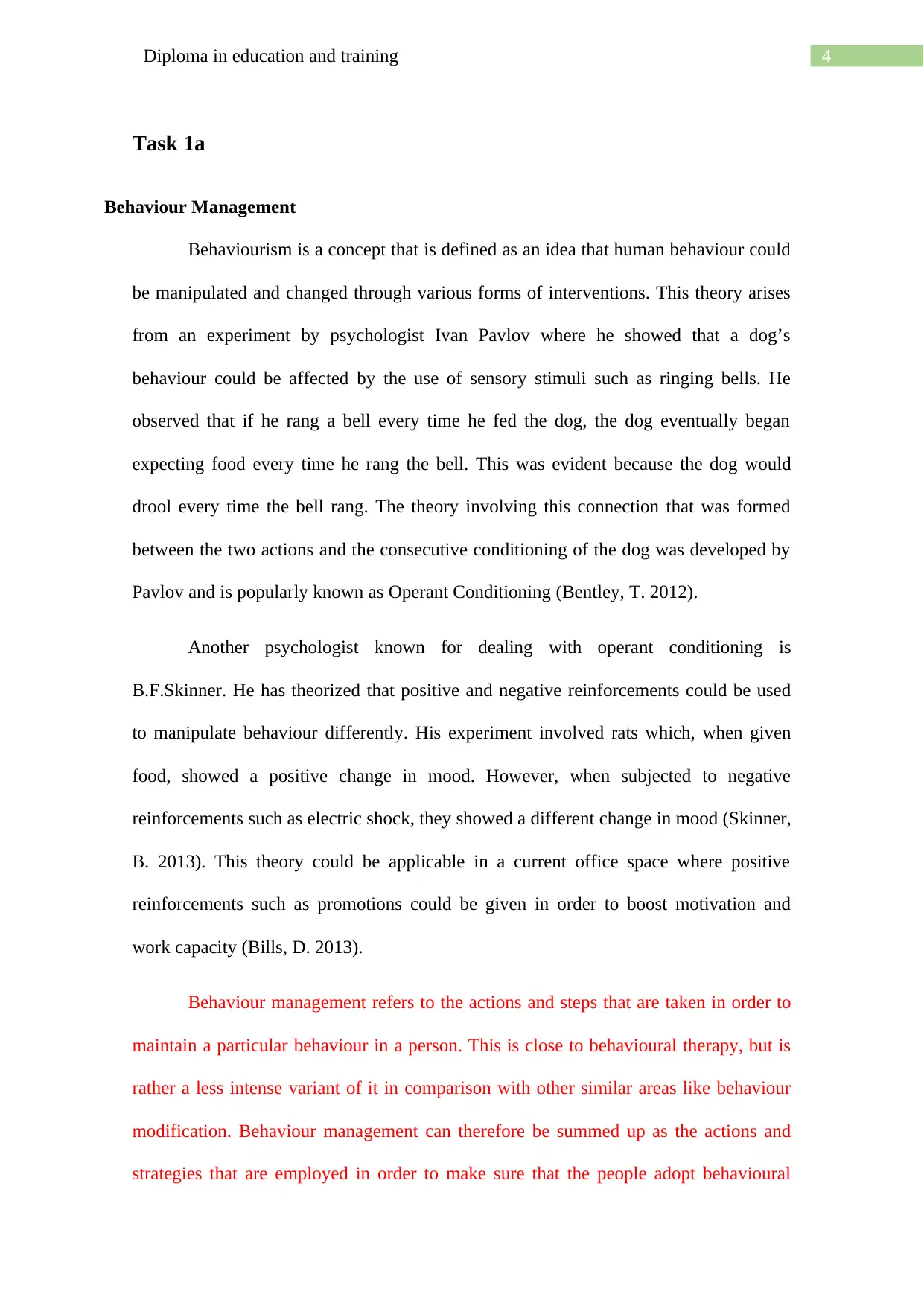
4Diploma in education and training
Task 1a
Behaviour Management
Behaviourism is a concept that is defined as an idea that human behaviour could
be manipulated and changed through various forms of interventions. This theory arises
from an experiment by psychologist Ivan Pavlov where he showed that a dog’s
behaviour could be affected by the use of sensory stimuli such as ringing bells. He
observed that if he rang a bell every time he fed the dog, the dog eventually began
expecting food every time he rang the bell. This was evident because the dog would
drool every time the bell rang. The theory involving this connection that was formed
between the two actions and the consecutive conditioning of the dog was developed by
Pavlov and is popularly known as Operant Conditioning (Bentley, T. 2012).
Another psychologist known for dealing with operant conditioning is
B.F.Skinner. He has theorized that positive and negative reinforcements could be used
to manipulate behaviour differently. His experiment involved rats which, when given
food, showed a positive change in mood. However, when subjected to negative
reinforcements such as electric shock, they showed a different change in mood (Skinner,
B. 2013). This theory could be applicable in a current office space where positive
reinforcements such as promotions could be given in order to boost motivation and
work capacity (Bills, D. 2013).
Behaviour management refers to the actions and steps that are taken in order to
maintain a particular behaviour in a person. This is close to behavioural therapy, but is
rather a less intense variant of it in comparison with other similar areas like behaviour
modification. Behaviour management can therefore be summed up as the actions and
strategies that are employed in order to make sure that the people adopt behavioural
Task 1a
Behaviour Management
Behaviourism is a concept that is defined as an idea that human behaviour could
be manipulated and changed through various forms of interventions. This theory arises
from an experiment by psychologist Ivan Pavlov where he showed that a dog’s
behaviour could be affected by the use of sensory stimuli such as ringing bells. He
observed that if he rang a bell every time he fed the dog, the dog eventually began
expecting food every time he rang the bell. This was evident because the dog would
drool every time the bell rang. The theory involving this connection that was formed
between the two actions and the consecutive conditioning of the dog was developed by
Pavlov and is popularly known as Operant Conditioning (Bentley, T. 2012).
Another psychologist known for dealing with operant conditioning is
B.F.Skinner. He has theorized that positive and negative reinforcements could be used
to manipulate behaviour differently. His experiment involved rats which, when given
food, showed a positive change in mood. However, when subjected to negative
reinforcements such as electric shock, they showed a different change in mood (Skinner,
B. 2013). This theory could be applicable in a current office space where positive
reinforcements such as promotions could be given in order to boost motivation and
work capacity (Bills, D. 2013).
Behaviour management refers to the actions and steps that are taken in order to
maintain a particular behaviour in a person. This is close to behavioural therapy, but is
rather a less intense variant of it in comparison with other similar areas like behaviour
modification. Behaviour management can therefore be summed up as the actions and
strategies that are employed in order to make sure that the people adopt behavioural
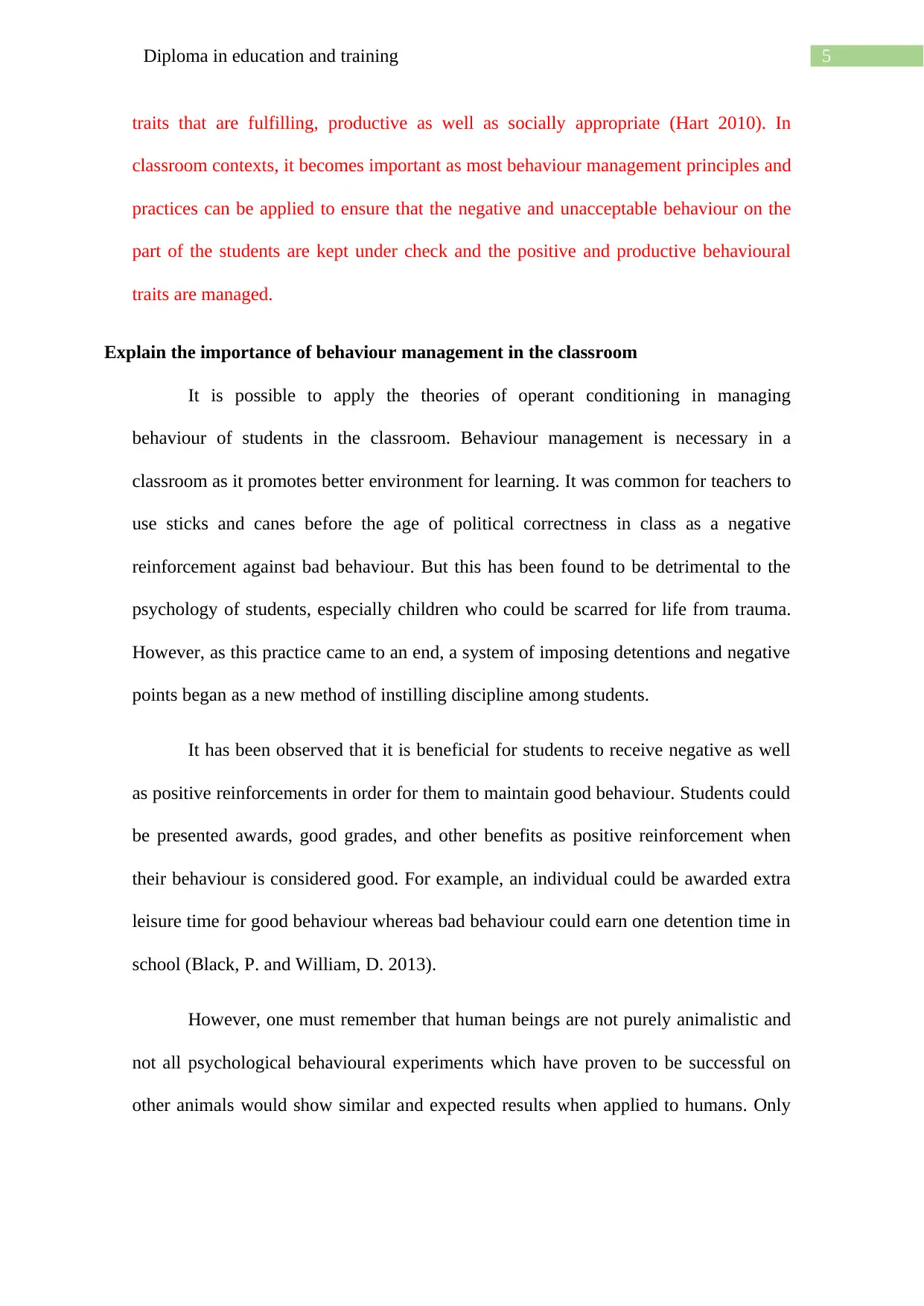
5Diploma in education and training
traits that are fulfilling, productive as well as socially appropriate (Hart 2010). In
classroom contexts, it becomes important as most behaviour management principles and
practices can be applied to ensure that the negative and unacceptable behaviour on the
part of the students are kept under check and the positive and productive behavioural
traits are managed.
Explain the importance of behaviour management in the classroom
It is possible to apply the theories of operant conditioning in managing
behaviour of students in the classroom. Behaviour management is necessary in a
classroom as it promotes better environment for learning. It was common for teachers to
use sticks and canes before the age of political correctness in class as a negative
reinforcement against bad behaviour. But this has been found to be detrimental to the
psychology of students, especially children who could be scarred for life from trauma.
However, as this practice came to an end, a system of imposing detentions and negative
points began as a new method of instilling discipline among students.
It has been observed that it is beneficial for students to receive negative as well
as positive reinforcements in order for them to maintain good behaviour. Students could
be presented awards, good grades, and other benefits as positive reinforcement when
their behaviour is considered good. For example, an individual could be awarded extra
leisure time for good behaviour whereas bad behaviour could earn one detention time in
school (Black, P. and William, D. 2013).
However, one must remember that human beings are not purely animalistic and
not all psychological behavioural experiments which have proven to be successful on
other animals would show similar and expected results when applied to humans. Only
traits that are fulfilling, productive as well as socially appropriate (Hart 2010). In
classroom contexts, it becomes important as most behaviour management principles and
practices can be applied to ensure that the negative and unacceptable behaviour on the
part of the students are kept under check and the positive and productive behavioural
traits are managed.
Explain the importance of behaviour management in the classroom
It is possible to apply the theories of operant conditioning in managing
behaviour of students in the classroom. Behaviour management is necessary in a
classroom as it promotes better environment for learning. It was common for teachers to
use sticks and canes before the age of political correctness in class as a negative
reinforcement against bad behaviour. But this has been found to be detrimental to the
psychology of students, especially children who could be scarred for life from trauma.
However, as this practice came to an end, a system of imposing detentions and negative
points began as a new method of instilling discipline among students.
It has been observed that it is beneficial for students to receive negative as well
as positive reinforcements in order for them to maintain good behaviour. Students could
be presented awards, good grades, and other benefits as positive reinforcement when
their behaviour is considered good. For example, an individual could be awarded extra
leisure time for good behaviour whereas bad behaviour could earn one detention time in
school (Black, P. and William, D. 2013).
However, one must remember that human beings are not purely animalistic and
not all psychological behavioural experiments which have proven to be successful on
other animals would show similar and expected results when applied to humans. Only
⊘ This is a preview!⊘
Do you want full access?
Subscribe today to unlock all pages.

Trusted by 1+ million students worldwide
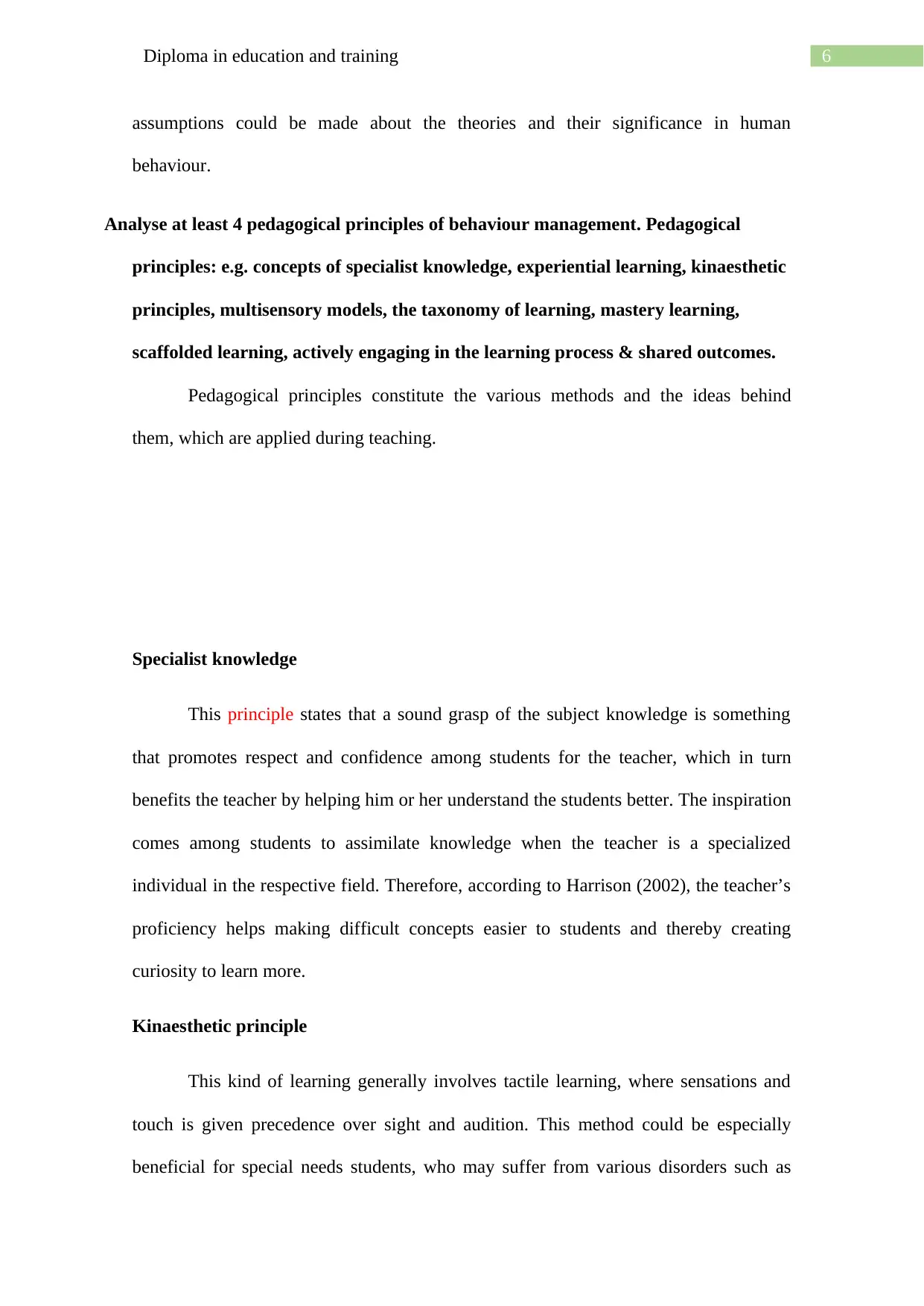
6Diploma in education and training
assumptions could be made about the theories and their significance in human
behaviour.
Analyse at least 4 pedagogical principles of behaviour management. Pedagogical
principles: e.g. concepts of specialist knowledge, experiential learning, kinaesthetic
principles, multisensory models, the taxonomy of learning, mastery learning,
scaffolded learning, actively engaging in the learning process & shared outcomes.
Pedagogical principles constitute the various methods and the ideas behind
them, which are applied during teaching.
Specialist knowledge
This principle states that a sound grasp of the subject knowledge is something
that promotes respect and confidence among students for the teacher, which in turn
benefits the teacher by helping him or her understand the students better. The inspiration
comes among students to assimilate knowledge when the teacher is a specialized
individual in the respective field. Therefore, according to Harrison (2002), the teacher’s
proficiency helps making difficult concepts easier to students and thereby creating
curiosity to learn more.
Kinaesthetic principle
This kind of learning generally involves tactile learning, where sensations and
touch is given precedence over sight and audition. This method could be especially
beneficial for special needs students, who may suffer from various disorders such as
assumptions could be made about the theories and their significance in human
behaviour.
Analyse at least 4 pedagogical principles of behaviour management. Pedagogical
principles: e.g. concepts of specialist knowledge, experiential learning, kinaesthetic
principles, multisensory models, the taxonomy of learning, mastery learning,
scaffolded learning, actively engaging in the learning process & shared outcomes.
Pedagogical principles constitute the various methods and the ideas behind
them, which are applied during teaching.
Specialist knowledge
This principle states that a sound grasp of the subject knowledge is something
that promotes respect and confidence among students for the teacher, which in turn
benefits the teacher by helping him or her understand the students better. The inspiration
comes among students to assimilate knowledge when the teacher is a specialized
individual in the respective field. Therefore, according to Harrison (2002), the teacher’s
proficiency helps making difficult concepts easier to students and thereby creating
curiosity to learn more.
Kinaesthetic principle
This kind of learning generally involves tactile learning, where sensations and
touch is given precedence over sight and audition. This method could be especially
beneficial for special needs students, who may suffer from various disorders such as
Paraphrase This Document
Need a fresh take? Get an instant paraphrase of this document with our AI Paraphraser
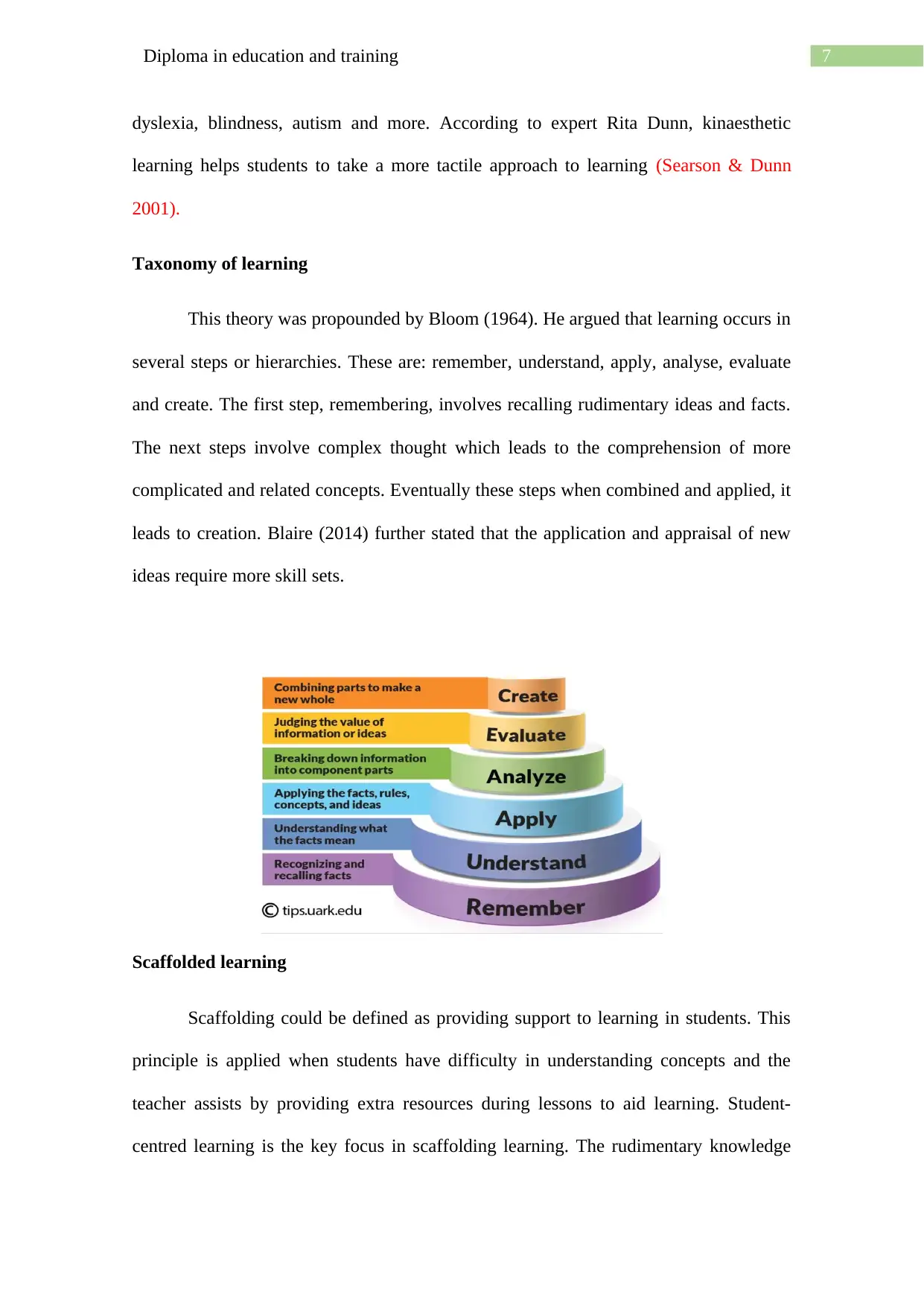
7Diploma in education and training
dyslexia, blindness, autism and more. According to expert Rita Dunn, kinaesthetic
learning helps students to take a more tactile approach to learning (Searson & Dunn
2001).
Taxonomy of learning
This theory was propounded by Bloom (1964). He argued that learning occurs in
several steps or hierarchies. These are: remember, understand, apply, analyse, evaluate
and create. The first step, remembering, involves recalling rudimentary ideas and facts.
The next steps involve complex thought which leads to the comprehension of more
complicated and related concepts. Eventually these steps when combined and applied, it
leads to creation. Blaire (2014) further stated that the application and appraisal of new
ideas require more skill sets.
Scaffolded learning
Scaffolding could be defined as providing support to learning in students. This
principle is applied when students have difficulty in understanding concepts and the
teacher assists by providing extra resources during lessons to aid learning. Student-
centred learning is the key focus in scaffolding learning. The rudimentary knowledge
dyslexia, blindness, autism and more. According to expert Rita Dunn, kinaesthetic
learning helps students to take a more tactile approach to learning (Searson & Dunn
2001).
Taxonomy of learning
This theory was propounded by Bloom (1964). He argued that learning occurs in
several steps or hierarchies. These are: remember, understand, apply, analyse, evaluate
and create. The first step, remembering, involves recalling rudimentary ideas and facts.
The next steps involve complex thought which leads to the comprehension of more
complicated and related concepts. Eventually these steps when combined and applied, it
leads to creation. Blaire (2014) further stated that the application and appraisal of new
ideas require more skill sets.
Scaffolded learning
Scaffolding could be defined as providing support to learning in students. This
principle is applied when students have difficulty in understanding concepts and the
teacher assists by providing extra resources during lessons to aid learning. Student-
centred learning is the key focus in scaffolding learning. The rudimentary knowledge
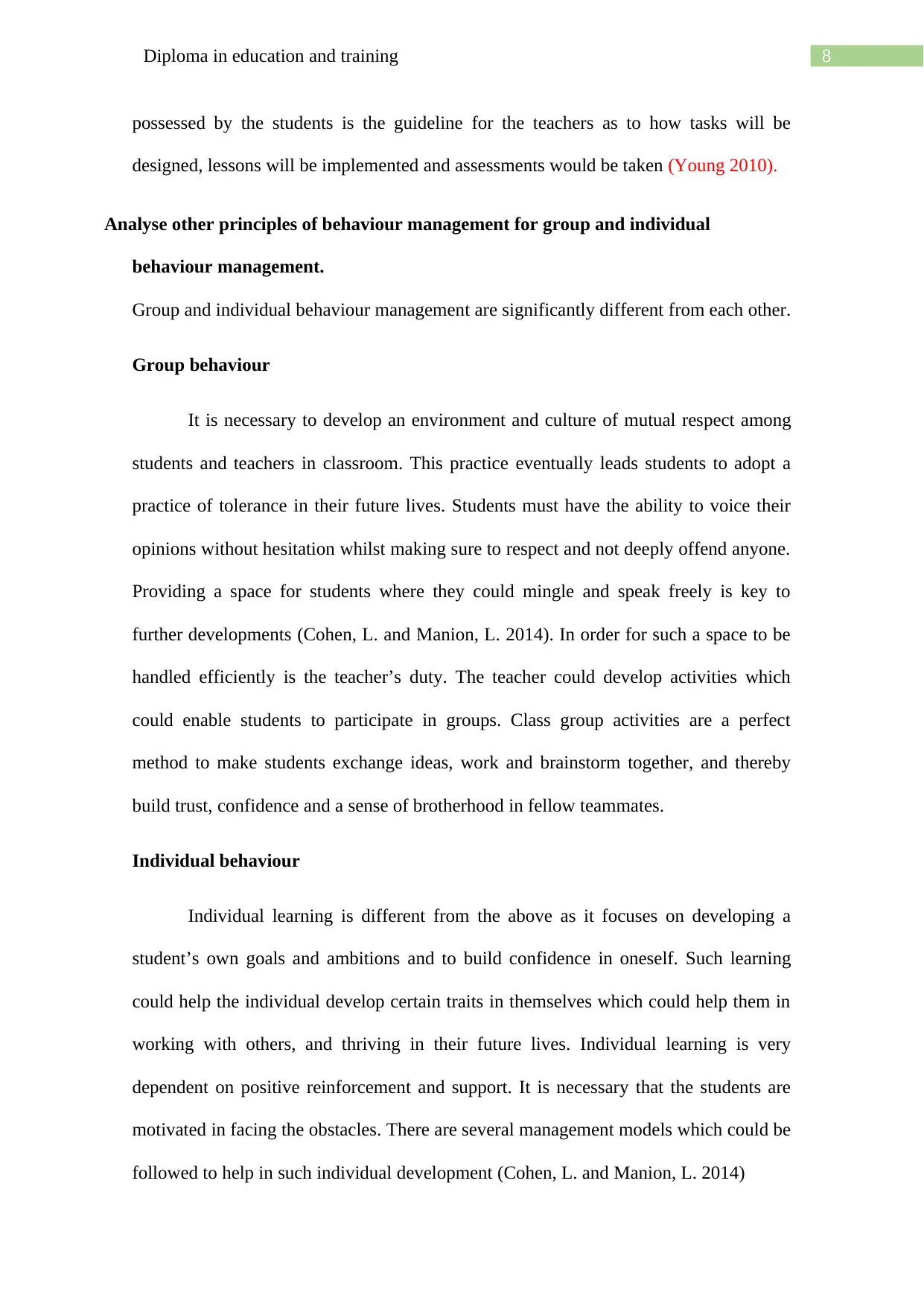
8Diploma in education and training
possessed by the students is the guideline for the teachers as to how tasks will be
designed, lessons will be implemented and assessments would be taken (Young 2010).
Analyse other principles of behaviour management for group and individual
behaviour management.
Group and individual behaviour management are significantly different from each other.
Group behaviour
It is necessary to develop an environment and culture of mutual respect among
students and teachers in classroom. This practice eventually leads students to adopt a
practice of tolerance in their future lives. Students must have the ability to voice their
opinions without hesitation whilst making sure to respect and not deeply offend anyone.
Providing a space for students where they could mingle and speak freely is key to
further developments (Cohen, L. and Manion, L. 2014). In order for such a space to be
handled efficiently is the teacher’s duty. The teacher could develop activities which
could enable students to participate in groups. Class group activities are a perfect
method to make students exchange ideas, work and brainstorm together, and thereby
build trust, confidence and a sense of brotherhood in fellow teammates.
Individual behaviour
Individual learning is different from the above as it focuses on developing a
student’s own goals and ambitions and to build confidence in oneself. Such learning
could help the individual develop certain traits in themselves which could help them in
working with others, and thriving in their future lives. Individual learning is very
dependent on positive reinforcement and support. It is necessary that the students are
motivated in facing the obstacles. There are several management models which could be
followed to help in such individual development (Cohen, L. and Manion, L. 2014)
possessed by the students is the guideline for the teachers as to how tasks will be
designed, lessons will be implemented and assessments would be taken (Young 2010).
Analyse other principles of behaviour management for group and individual
behaviour management.
Group and individual behaviour management are significantly different from each other.
Group behaviour
It is necessary to develop an environment and culture of mutual respect among
students and teachers in classroom. This practice eventually leads students to adopt a
practice of tolerance in their future lives. Students must have the ability to voice their
opinions without hesitation whilst making sure to respect and not deeply offend anyone.
Providing a space for students where they could mingle and speak freely is key to
further developments (Cohen, L. and Manion, L. 2014). In order for such a space to be
handled efficiently is the teacher’s duty. The teacher could develop activities which
could enable students to participate in groups. Class group activities are a perfect
method to make students exchange ideas, work and brainstorm together, and thereby
build trust, confidence and a sense of brotherhood in fellow teammates.
Individual behaviour
Individual learning is different from the above as it focuses on developing a
student’s own goals and ambitions and to build confidence in oneself. Such learning
could help the individual develop certain traits in themselves which could help them in
working with others, and thriving in their future lives. Individual learning is very
dependent on positive reinforcement and support. It is necessary that the students are
motivated in facing the obstacles. There are several management models which could be
followed to help in such individual development (Cohen, L. and Manion, L. 2014)
⊘ This is a preview!⊘
Do you want full access?
Subscribe today to unlock all pages.

Trusted by 1+ million students worldwide
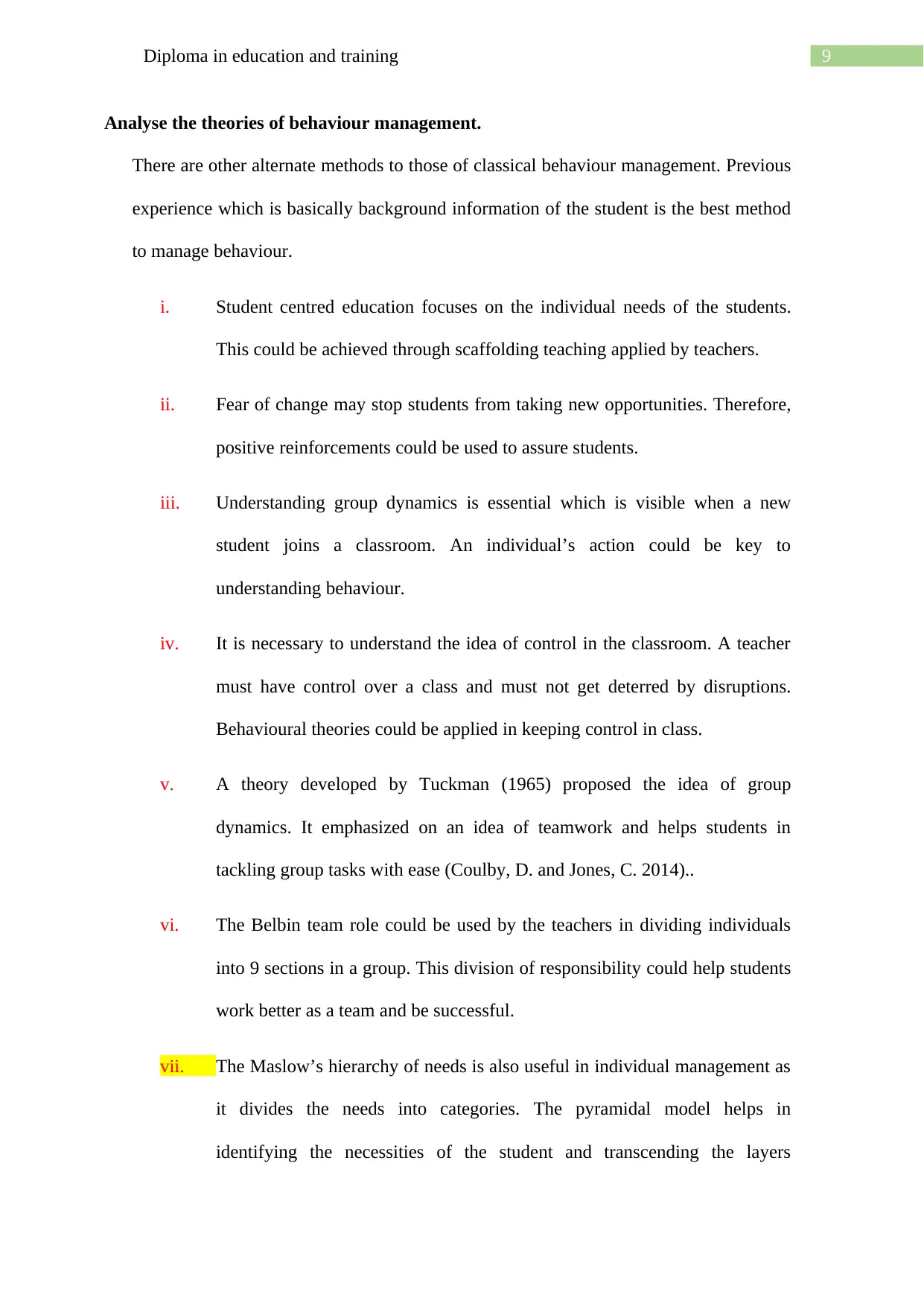
9Diploma in education and training
Analyse the theories of behaviour management.
There are other alternate methods to those of classical behaviour management. Previous
experience which is basically background information of the student is the best method
to manage behaviour.
i. Student centred education focuses on the individual needs of the students.
This could be achieved through scaffolding teaching applied by teachers.
ii. Fear of change may stop students from taking new opportunities. Therefore,
positive reinforcements could be used to assure students.
iii. Understanding group dynamics is essential which is visible when a new
student joins a classroom. An individual’s action could be key to
understanding behaviour.
iv. It is necessary to understand the idea of control in the classroom. A teacher
must have control over a class and must not get deterred by disruptions.
Behavioural theories could be applied in keeping control in class.
v. A theory developed by Tuckman (1965) proposed the idea of group
dynamics. It emphasized on an idea of teamwork and helps students in
tackling group tasks with ease (Coulby, D. and Jones, C. 2014)..
vi. The Belbin team role could be used by the teachers in dividing individuals
into 9 sections in a group. This division of responsibility could help students
work better as a team and be successful.
vii. The Maslow’s hierarchy of needs is also useful in individual management as
it divides the needs into categories. The pyramidal model helps in
identifying the necessities of the student and transcending the layers
Analyse the theories of behaviour management.
There are other alternate methods to those of classical behaviour management. Previous
experience which is basically background information of the student is the best method
to manage behaviour.
i. Student centred education focuses on the individual needs of the students.
This could be achieved through scaffolding teaching applied by teachers.
ii. Fear of change may stop students from taking new opportunities. Therefore,
positive reinforcements could be used to assure students.
iii. Understanding group dynamics is essential which is visible when a new
student joins a classroom. An individual’s action could be key to
understanding behaviour.
iv. It is necessary to understand the idea of control in the classroom. A teacher
must have control over a class and must not get deterred by disruptions.
Behavioural theories could be applied in keeping control in class.
v. A theory developed by Tuckman (1965) proposed the idea of group
dynamics. It emphasized on an idea of teamwork and helps students in
tackling group tasks with ease (Coulby, D. and Jones, C. 2014)..
vi. The Belbin team role could be used by the teachers in dividing individuals
into 9 sections in a group. This division of responsibility could help students
work better as a team and be successful.
vii. The Maslow’s hierarchy of needs is also useful in individual management as
it divides the needs into categories. The pyramidal model helps in
identifying the necessities of the student and transcending the layers
Paraphrase This Document
Need a fresh take? Get an instant paraphrase of this document with our AI Paraphraser
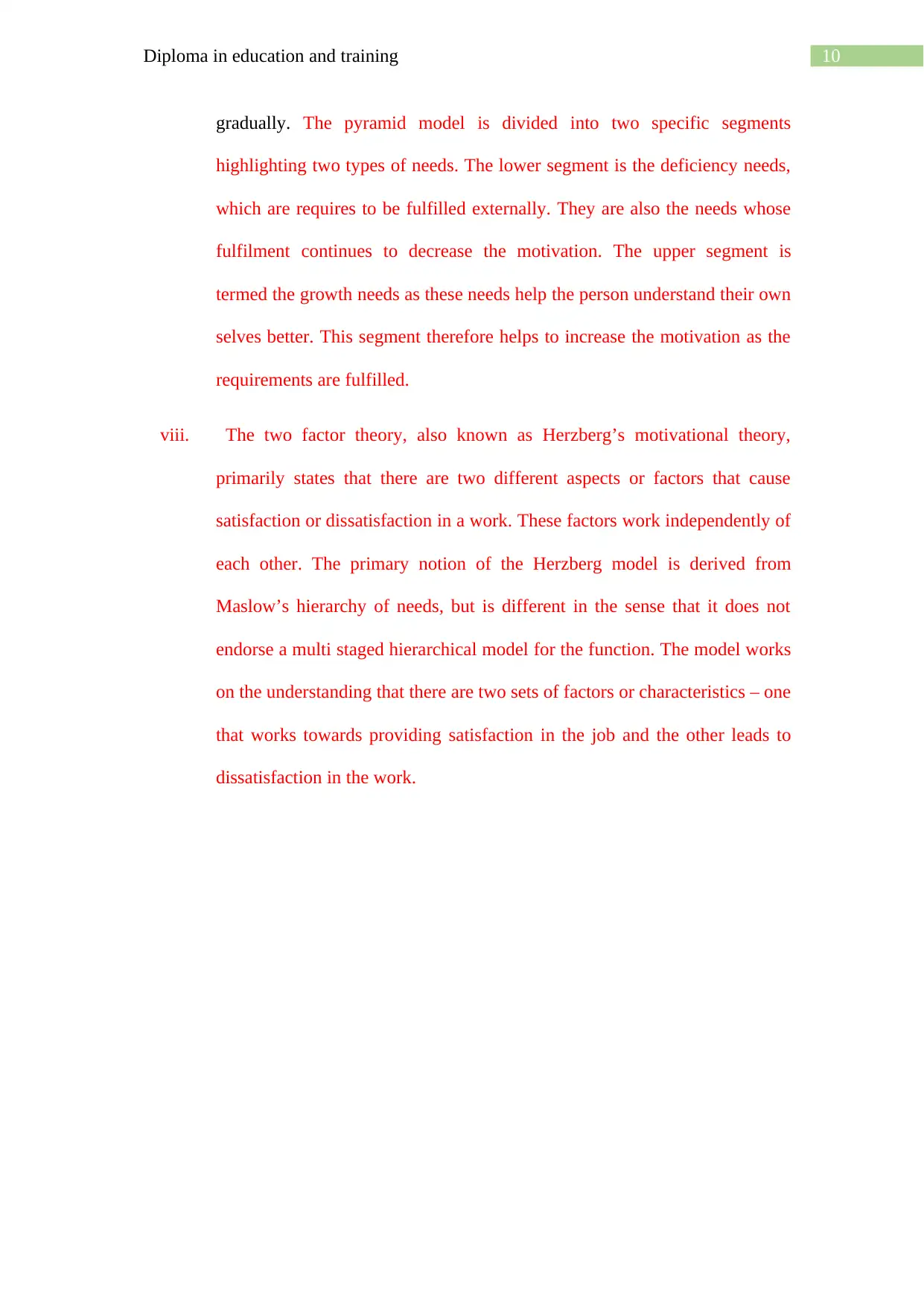
10Diploma in education and training
gradually. The pyramid model is divided into two specific segments
highlighting two types of needs. The lower segment is the deficiency needs,
which are requires to be fulfilled externally. They are also the needs whose
fulfilment continues to decrease the motivation. The upper segment is
termed the growth needs as these needs help the person understand their own
selves better. This segment therefore helps to increase the motivation as the
requirements are fulfilled.
viii. The two factor theory, also known as Herzberg’s motivational theory,
primarily states that there are two different aspects or factors that cause
satisfaction or dissatisfaction in a work. These factors work independently of
each other. The primary notion of the Herzberg model is derived from
Maslow’s hierarchy of needs, but is different in the sense that it does not
endorse a multi staged hierarchical model for the function. The model works
on the understanding that there are two sets of factors or characteristics – one
that works towards providing satisfaction in the job and the other leads to
dissatisfaction in the work.
gradually. The pyramid model is divided into two specific segments
highlighting two types of needs. The lower segment is the deficiency needs,
which are requires to be fulfilled externally. They are also the needs whose
fulfilment continues to decrease the motivation. The upper segment is
termed the growth needs as these needs help the person understand their own
selves better. This segment therefore helps to increase the motivation as the
requirements are fulfilled.
viii. The two factor theory, also known as Herzberg’s motivational theory,
primarily states that there are two different aspects or factors that cause
satisfaction or dissatisfaction in a work. These factors work independently of
each other. The primary notion of the Herzberg model is derived from
Maslow’s hierarchy of needs, but is different in the sense that it does not
endorse a multi staged hierarchical model for the function. The model works
on the understanding that there are two sets of factors or characteristics – one
that works towards providing satisfaction in the job and the other leads to
dissatisfaction in the work.
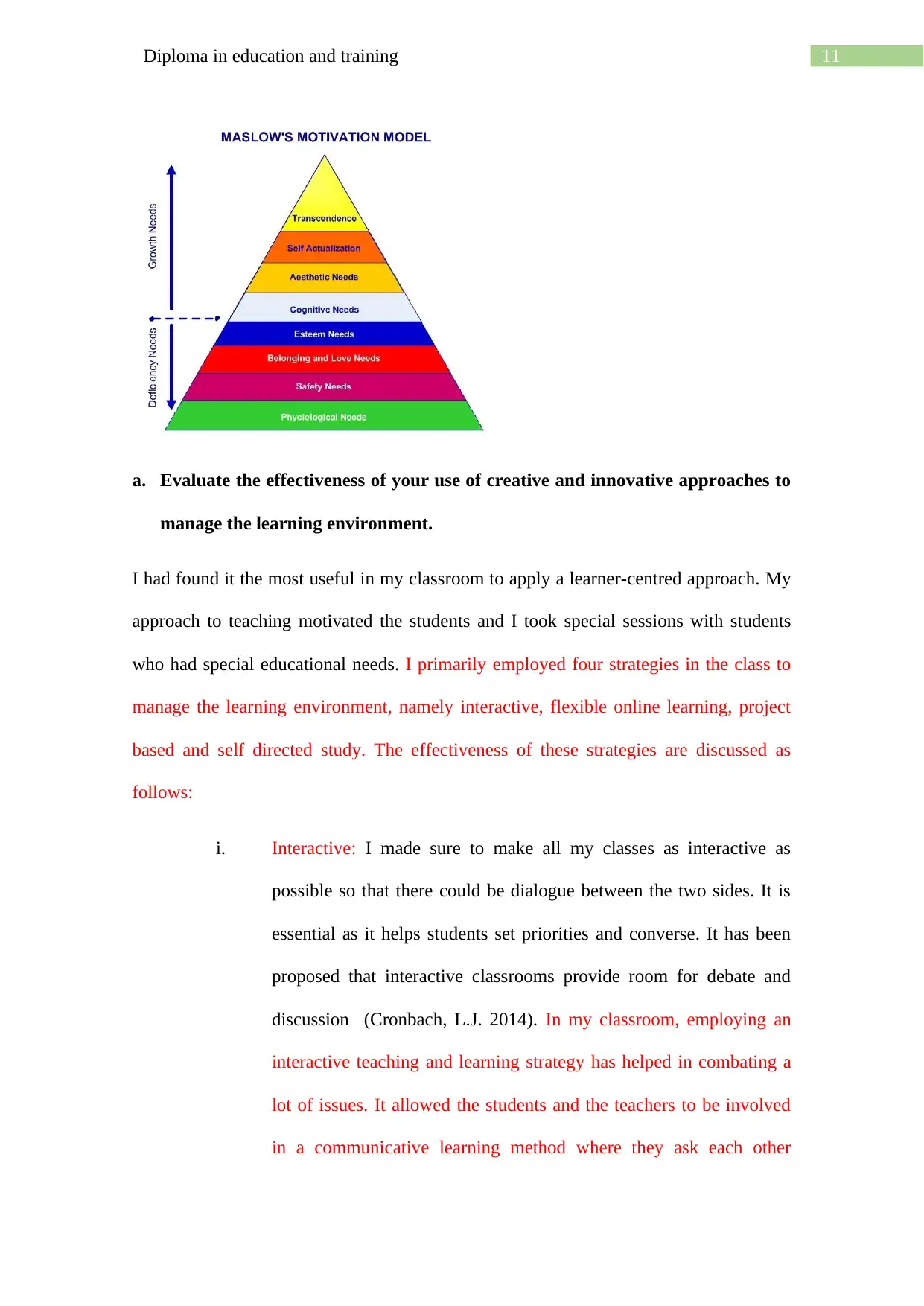
11Diploma in education and training
a. Evaluate the effectiveness of your use of creative and innovative approaches to
manage the learning environment.
I had found it the most useful in my classroom to apply a learner-centred approach. My
approach to teaching motivated the students and I took special sessions with students
who had special educational needs. I primarily employed four strategies in the class to
manage the learning environment, namely interactive, flexible online learning, project
based and self directed study. The effectiveness of these strategies are discussed as
follows:
i. Interactive: I made sure to make all my classes as interactive as
possible so that there could be dialogue between the two sides. It is
essential as it helps students set priorities and converse. It has been
proposed that interactive classrooms provide room for debate and
discussion (Cronbach, L.J. 2014). In my classroom, employing an
interactive teaching and learning strategy has helped in combating a
lot of issues. It allowed the students and the teachers to be involved
in a communicative learning method where they ask each other
a. Evaluate the effectiveness of your use of creative and innovative approaches to
manage the learning environment.
I had found it the most useful in my classroom to apply a learner-centred approach. My
approach to teaching motivated the students and I took special sessions with students
who had special educational needs. I primarily employed four strategies in the class to
manage the learning environment, namely interactive, flexible online learning, project
based and self directed study. The effectiveness of these strategies are discussed as
follows:
i. Interactive: I made sure to make all my classes as interactive as
possible so that there could be dialogue between the two sides. It is
essential as it helps students set priorities and converse. It has been
proposed that interactive classrooms provide room for debate and
discussion (Cronbach, L.J. 2014). In my classroom, employing an
interactive teaching and learning strategy has helped in combating a
lot of issues. It allowed the students and the teachers to be involved
in a communicative learning method where they ask each other
⊘ This is a preview!⊘
Do you want full access?
Subscribe today to unlock all pages.

Trusted by 1+ million students worldwide
1 out of 40
Related Documents
Your All-in-One AI-Powered Toolkit for Academic Success.
+13062052269
info@desklib.com
Available 24*7 on WhatsApp / Email
![[object Object]](/_next/static/media/star-bottom.7253800d.svg)
Unlock your academic potential
Copyright © 2020–2025 A2Z Services. All Rights Reserved. Developed and managed by ZUCOL.




